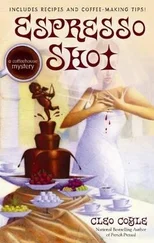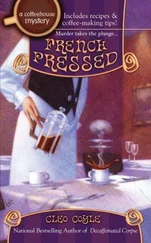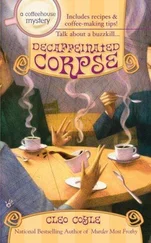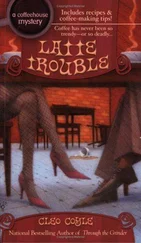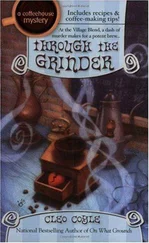“This is not the time or place, Clare.” His expression was still rigid, but when he spoke once more, his tone was softer. “Please.” He stepped close, put his hands on my shoulders. “Let’s not do this. Let’s go check on your friends.”
I didn’t argue. Not then. Mike wasn’t wrong about the timing. So I shelved my questions (for the moment) and let him guide me through the doors of the emergency room.
“Osso buco is another example,” Madame was saying.
“Is that beef? Like the bourguignon?” The voice was gruffly male, its pitch low enough to dub James Earl Jones.
“Veal, dear. The veal hind shank, to be precise, sawed into three-inch-thick pieces...”
As I came around the white partitioning curtain in the busy ER, I found Madame regally propped on the pristine sheets of a narrow hospital stretcher. Her silk pantsuit was still smoke stained and wrinkled, but her face was freshly washed, her hair brushed into a sleek silver pageboy.
Relief washed over me — along with fear, anger, gratefulness — the internal emotional swell was nearly as powerful as the moment I’d seen her carried out of that charred caffè.
She hadn’t yet noticed me. Her focus was on the man occupying the next stretcher, and I was glad of that. It gave me a few moments to swallow back tears, compose myself.
“So how hard is to make?” asked Madame’s ER neighbor.
The bare-chested guy wore black leather pants and a Vandyke beard long enough to braid. Every inch of skin art along his muscled arms had something to do with Harley Davidson, and if that weren’t enough of a giveaway, the flaming hog across his chest released scripted exhaust that plainly read Hells Angels.
“Osso buco? It’s a snap!” Madame chirped. “Salt and pepper the shanks, dredge them in flour, and brown them in a skillet with a bit of olive oil. Then just cover with a mixture of chicken or veal stock, sautéed onions, carrots, and celery and dry white wine — or French vermouth, whichever you prefer.”
“I like bourbon. Can I use bourbon?”
“I wouldn’t.”
“So why put flour on the shanks if you’re covering ’em with stock, anyways?”
“As the shanks are braising, flour will thicken the sauce for you. Then there’s no need for more difficult measures.”
“I get it. Cooking time?”
“Two hours or so. Finish with a sprinkle of gremolata to add a sprightly flavor note.”
“Gremo-what-a?”
“It’s just a bit of minced garlic with chopped parsley and zest from a lemon.”
“Oh, zest ! I know zest! I seen them make zest on the Food Channel. You grate it off citrus skins with a metal file, right?”
“Almost, dear. That zesting tool is called a Microplane — ”
I cleared my throat. Madame turned. “Clare!”
I stepped into her open arms, and the festive aroma of grappa on her breath lifted my spirits. The clashing acrid-ness of smoke in her hair, however, ignited other feelings — ugly ones. I wanted to know who was responsible for putting her here, and I wanted them to pay.
“How are you, Madame?”
“Fit as a Stradivarius.”
“Did you call Otto?”
Otto Visser was the “younger man” in Madame’s life. (He was only pushing seventy.) The dignified, European-born gallery owner had become smitten with my former mother-in-law after they’d eye-flirted across a semicrowded Manhattan dining room. The two had been a couple ever since.
“I’m not troubling Otto with this,” Madame stated.
“That’s crazy.” I pulled out my cell. “I’ll call him.”
“Please don’t.”
“For heaven’s sake, why not?”
“Otto’s hosting an important dinner between a promising young painter and a very serious Japanese collector. I wouldn’t dream of doing anything to hurt the artist’s prospects.”
Considering what the woman had just gone through, I found that reply frustrating, although I knew where it came from. For decades, Madame had run our Village Blend as a second home for poets, writers, dramatists, and yes — as cliché as it sounded — struggling fine artists.
Actors, dancers, singers, writers, visual artists, and students burning to prove themselves worthy of said identifiers still frequented our Village coffeehouse. But the neighborhood’s skyrocketing real estate values had driven the majority of them to more affordable neighborhoods in Brooklyn, here in Queens, and (in the case of many jazz musicians) North Jersey.
Back in Madame’s prime, however, when Greenwich Village was still a “cheap” place to live on Manhattan island, she’d befriended some true legends of the art world (before they’d become legends): Hopper, Pollock, de Kooning, Rauschenberg, Warhol, Lichtenstein, even the graffiti prodigy Jean-Michel Basquiat.
She’d also known artists, just as talented, who’d failed. Not in their art but in their ability to make a passable living at it. What the bottle and needle didn’t claim, the demands of day jobs or young families did. So it was no mystery to me why Madame didn’t want to feel responsible for interfering with even one aspiring artist’s sale.
Still, I had to point out: “When Otto finds out, he’ll be extremely upset that you didn’t call.”
Madame waved her hand. “To tell you the truth, dear, the last time I was in harm’s way — you recall, don’t you? At Matteo’s wedding last year?”
“The shooting?”
“Yes, for weeks after that little incident, Otto was solicitous to the point of annoyance. I’d rather not go through that again. I do adore the man, but a woman needs her space.”
Madame glanced up then, beyond me, into the vast fluorescent bustle of the ER’s central area. “And where is your knightly young officer?”
Knightly? That’s a first. I pointed . “Waiting room.”
“I must tell you, Clare, he took excellent care of me, found me a sparkling water, brought me a hairbrush and mirror. Oh!” She pointed to my shoulder. “I see you have my bag. At last, I can do my makeup.”
I handed over the recovered booty. As Madame pulled out her compact and lipstick, I heard male laughter and hearty greetings coming through the closed curtain to her right. That patient, whoever he was, had just gotten a visitor. At the same moment, I realized the Biker Guy on the stretcher to the left of Madame was watching us with interest — easy enough to do because the partitioning curtain on his side was pulled completely open.
“Howyadoin’?” he called when he noticed me noticing him.
“Fine,” I replied, then gestured to the plastic brace around his neck (the one beneath his narrow version of a ZZ Top beard). “What happened? Traffic accident? Spin out?”
“Slipped in the shower.”
“Oh...”
“Clare, this is Diggy-Dog Dare.” Madame turned to the biker. “Diggy, this is Clare Cosi, my daughter-in-law — ”
“Ex,” I corrected, and not for the first time.
“Charmed, I’m sure,” Diggy replied in basso profundo.
“Before you arrived, we were exchanging recipes,” Madame explained. “Diggy gave me his favorite: tequila chicken.”
“With tomatillo sauce,” Diggy noted.
“And I gave him my bourguignon-style short ribs and — ”
“Osso buco,” I interjected with a nod. “I overheard.”
Madame tapped her chin. “Now that I think of it, dear, didn’t you used to make a steak with bourbon sauce? I recall Matt raving about it and Diggy has a proclivity for bourbon. Don’t you, Diggy?”
“A proclivity? No. But I do like it a lot.”
“Of course, Matt always raved about your cooking,” Madame went on. She turned back to Diggy. “Matt’s my son. He and Clare have the most beautiful daughter together.”
Читать дальше





